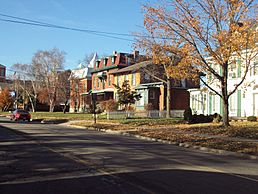East Elm–North Macomb Street Historic District facts for kids
Quick facts for kids |
|
|
East Elm–North Macomb Street
Historic District |
|

The historic district along East Elm Avenue
|
|
| Location | Monroe, Michigan |
|---|---|
| Area | 0.75 sq mi (1.9 km2) |
| NRHP reference No. | 82002853 |
| Added to NRHP | May 6, 1982 |
The East Elm–North Macomb Street Historic District is a special area in Monroe, Michigan. It's like a neighborhood that has been officially recognized for its important history and old buildings. This district was added to the National Register of Historic Places on May 6, 1982. This means it's a place worth protecting because of its past.
This historic district covers about 0.75 square miles (1.9 km2) of land. It's located near the River Raisin to the south and North Monroe Street (M-125) to the west. The district stretches north to East Lorain Street and east to North Macomb Street. Other streets inside this area include Tremont, East Willow, East Vine, East Noble, Gee, Sackett, and Glendale.
A Look Back: History of the District
Some of the oldest houses in this district were built way back in 1820. This was when the area first started to grow. Houses were built along the river road, which is now called Elm Avenue, close to the Monroe Street bridge.
Later in the 1800s, more houses began to appear north of Elm Avenue. Over the next 100 years, the area slowly grew into a neighborhood just for homes. It became a popular place to live because it had nice views and was easy to get to downtown. By the 1920s, the entire area was full of buildings.
What You'll See: Exploring the District
The East Elm–North Macomb Street Historic District is home to many different styles of old houses. You can see homes built in styles like Greek Revival, Federal, Second Empire, and Victorian architecture. There are also some newer homes from the 1900s, like bungalows and houses with a Prairie-influenced design.
Most of the buildings in this district are private homes. They range from very large mansions to smaller houses and apartments. Along North Monroe Street, you'll also find some small businesses.
The oldest part of the district has two areas that were planned in 1836. Here, you'll find beautiful mansions along Elm Avenue. A few early suburban houses are still located north of Elm. The rest of the district has more modest homes built in the late 1800s and early 1900s.
A very important house in this district is the Governor Robert McClelland House. It's also listed on the National Register of Historic Places and is located at 47 East Elm Street. Robert McClelland was a politician who lived in this house for a short time in 1841. He was the mayor of Monroe before he became involved in national politics.
The East Elm–North Macomb Street Historic District is also located across North Monroe Street from the St. Mary's Church Complex Historic District. It's also right next to the George Armstrong Custer Equestrian Monument.



